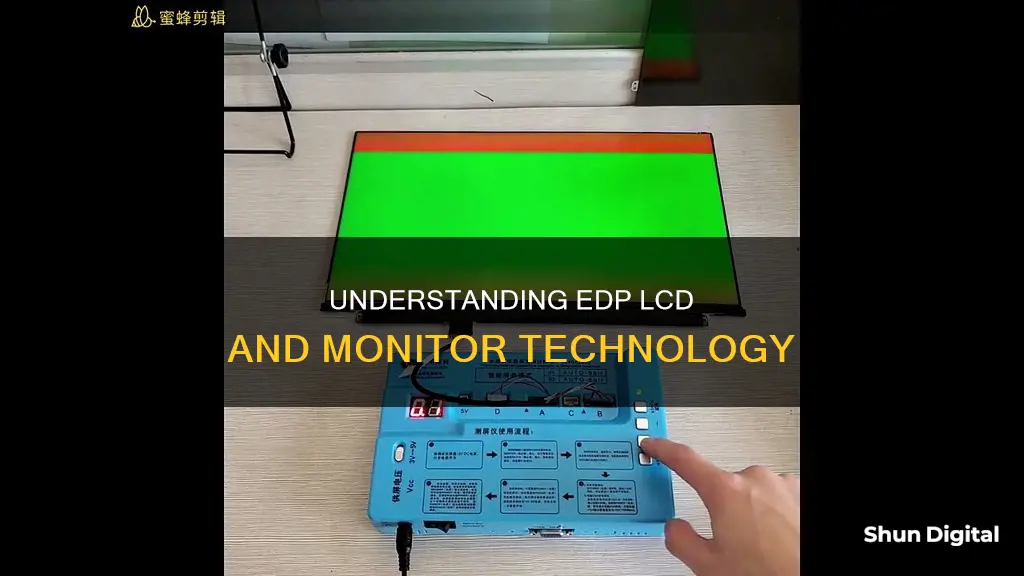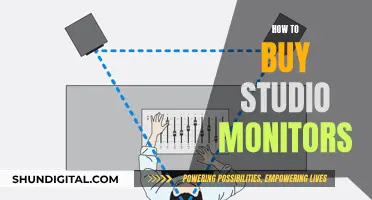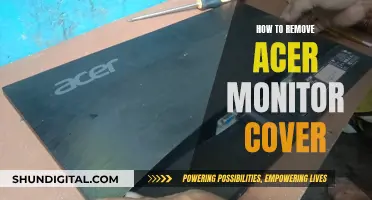
The eDP interface is a fully digital interface based on DisplayPort architecture and protocol. It is used for LCD monitors and is designed to replace the aging LVDS standard. EDP allows for the transmission of high-resolution signals with a simpler connector design and fewer pins, making it suitable for devices such as tablet PCs, laptops, and all-in-one computers. It also supports simultaneous transmission of multiple data types, resulting in a much higher transmission rate compared to LVDS.
What You'll Learn

EDP vs LVDS
EDP (Embedded Display Port) and LVDS (Low-Voltage Differential Signalling) are both video signal interfaces used to connect touch screens or monitors in industrial computers. They are both high-speed display connection technologies used in industrial PCs, with EDP being the newer standard.
LVDS uses very low voltage swing (about 350mV) to transmit data on two PCBs or a pair of balanced cables through differential, low voltage differential signal transmission. It is a digital video signal transmission mode developed to overcome the disadvantages of high power consumption and EMI when transmitting broadband high bit rate data by TTL level. The LVDS output interface is used in industrial computers, allowing the signal to transmit at a rate of several hundred Mbit/s on the differential PCB line or balanced cable. Due to the low voltage and low current drive mode, low noise and low power consumption are achieved.
EDP, on the other hand, is a fully digital interface based on DisplayPort architecture and protocol. It can transmit high-resolution signals with simpler connectors and fewer pins, and it can support the simultaneous transmission of multiple data types, resulting in a much higher transmission rate than LVDS. EDP also uses fewer conductors in cable design, reducing space and cost. Additionally, EDP cables allow for easy connection between a source (such as a personal computer) and an LCD.
When choosing between EDP and LVDS, there are several factors to consider:
- Resolution: LVDS is better suited for larger displays with higher resolutions, while EDP is capable of supporting high resolutions and frame rates, making it ideal for embedded systems and mobile devices.
- Bandwidth: LVDS has a higher bandwidth, making it preferable for applications requiring high-speed data transmission. However, EDP has a high data transfer rate of up to 8.64 Gbit/s with four data pairs, making it a good option for high-quality display performance.
- Power consumption: EDP offers a low-power display solution, making it more suitable for battery-powered devices.
- Cost: EDP is designed to be cost-effective, striking a balance between performance and expense.
In conclusion, both EDP and LVDS have their advantages and are widely used in various applications. However, with its higher data transfer rate, support for multiple data types, reduced space and cost, and easy connectivity, EDP has largely replaced LVDS for laptop and tablet displays.
Cleaning the Asus SonicMaster Monitor: A Step-by-Step Guide
You may want to see also

EDP interface
The EDP interface is a fully digital interface based on DisplayPort architecture and protocol. It is a high-performance audio/visual interface that allows displays to display in 4k and beyond. EDP stands for Embedded DisplayPort and is based on the VESA DisplayPort Standard.
EDP is a simplified version of DisplayPort for internal displays. It was developed by the Video Electronics Standards Association (VESA) and released in 2009 as an extension of the DisplayPort standard for use with embedded displays. EDP was designed to replace the aging Low-Voltage Differential Signalling (LVDS) standard.
EDP can transmit high-resolution signals with simpler connectors and fewer pins, and it supports the simultaneous transmission of multiple data types. This gives it a much higher transmission rate than LVDS. EDP also has a tiny EMI (electromagnetic interference) output and a powerful copyright protection function.
EDP is suitable for use in tablet PCs, laptops, all-in-one computers, and future mobile phones with large screens and high-resolution displays. It is becoming increasingly optimized for smaller form factor systems, including tablets and PC smartphones.
Monitor Size Impact on FPS: Does Bigger Mean Better?
You may want to see also

EDP cables
EDP stands for Embedded DisplayPort and is based on the VESA DisplayPort Standard. EDP is a high-performance audio/visual interface developed through the personal computer industry, which allows displays to display in 4K and beyond. EDP cables have become a popular replacement for LVDS display cables, which have been the standard since the mid-1990s.
Monitoring Memory Usage on AIX: Key Strategies and Techniques
You may want to see also

EDP standard
The EDP interface, or Embedded DisplayPort, is a fully digital interface based on the DisplayPort architecture and protocol. It is a high-performance audio/visual interface that allows displays to show 4k and higher resolutions. EDP is an extension of the DisplayPort standard, developed by the Video Electronics Standards Association (VESA) to replace the Low-Voltage Differential Signaling (LVDS) standard.
EDP offers a range of benefits over LVDS. Firstly, it can transmit high-resolution signals with simpler connectors and fewer pins, reducing the number of wires in the interface and the number of pins for the interface. This also makes it more suitable for smaller devices. Secondly, it supports the simultaneous transmission of multiple data types, including audio and video, and has a higher transmission rate than LVDS. Thirdly, it does not require an LVDS conversion circuit, instead using a simple layout circuit. Finally, it produces tiny EMI (electromagnetic interference) and has a powerful copyright protection function.
EDP is widely used in notebook computers and all-in-one systems, and is becoming more common in smaller form factor systems like tablets and smartphones. It is also used in industrial PCs and industrial tablet PCs.
Monitor Internet Usage: Airport Extreme Settings Guide
You may want to see also

EDP v1.4
EDP, or Embedded DisplayPort, is a high-performance audio/visual interface that allows displays to display in 4K and beyond. EDP is based on the VESA DisplayPort Standard and is a fully digital interface based on DisplayPort architecture and protocol. It can transmit high-resolution signals with simple connectors and few pins, and can support the simultaneous transmission of multiple data types, including video, audio, and others. This makes its transmission speed much higher than LVDS.
Monitoring Xbox Usage: Parental Control and Time Management
You may want to see also
Frequently asked questions
EDP stands for Embedded DisplayPort, which is based on the VESA DisplayPort Standard. It is a high-performance audio/visual interface that allows displays to show in 4k and beyond.
LCD stands for Liquid Crystal Display. An LCD monitor is a flat-panel display that uses a liquid crystal layer to display images and text.
EDP is a type of interface used in LCD monitors. It is a fully digital interface that can transmit high-resolution signals with simpler connectors and fewer pins.
The EDP interface offers higher transmission speeds, simultaneous transmission of multiple data, and reduced EMI (electromagnetic interference). It also requires fewer wires and is more suitable for high-resolution screens.
The EDP interface is commonly used in tablet PCs, laptops, all-in-one computers, and high-resolution tablets. It is also being optimized for smaller form factor systems, including smartphones.







